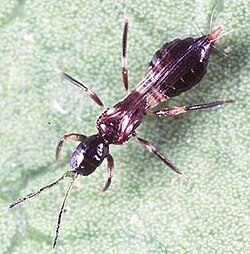This article includes a list of general references, but it lacks sufficient corresponding inline citations .(November 2017) |
| Terebrantia | |
|---|---|
 | |
| Adult Franklinothrips vespiformis (Aeolothripidae), a widely distributed tropical species | |
| Scientific classification | |
| Domain: | Eukaryota |
| Kingdom: | Animalia |
| Phylum: | Arthropoda |
| Class: | Insecta |
| Order: | Thysanoptera |
| Suborder: | Terebrantia Haliday, 1836 [1] |
| Families | |
Terebrantia is a suborder of thrips (order Thysanoptera). Order Thysanoptera includes 5,500 species classified into two suborders distinguished by the ovipositor. Terebrantia have a well-developed conical ovipositor, while the Tubulifera do not. It contains 13 families, five of which are only known from fossils. Members of Terebrantia mainly feed on plants. All have two larval instars followed by two pupal instars. [2]
| Thysanoptera |
| ||||||||||||